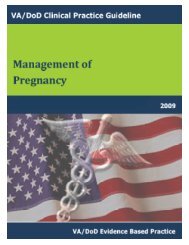DM Full Guideline (2010) - VA/DoD Clinical Practice Guidelines Home
DM Full Guideline (2010) - VA/DoD Clinical Practice Guidelines Home
DM Full Guideline (2010) - VA/DoD Clinical Practice Guidelines Home
Create successful ePaper yourself
Turn your PDF publications into a flip-book with our unique Google optimized e-Paper software.
Version 4.0<br />
<strong>VA</strong>/<strong>DoD</strong> <strong>Clinical</strong> <strong>Practice</strong> <strong>Guideline</strong><br />
for the Management of Diabetes Mellitus<br />
A. Has Patient’s Vision Changed Recently<br />
OBJECTIVE<br />
MODULE E– EYE CARE<br />
ANNOTATIONS<br />
Identify patients with diabetes mellitus (<strong>DM</strong>) in need of urgent referral to an eye care provider.<br />
RECOMMENDATIONS<br />
1. Patients with an acute change in vision or a change in ocular function should be urgently referred to an eye<br />
care provider.<br />
DISCUSSION<br />
Symptoms such as blurring or loss of vision, severe pain or light sensitivity, double vision, distortion, floaters, or<br />
light flashes may indicate a serious ocular problem. Such complaints require urgent referral to an eye care provider.<br />
Visual symptoms clearly associated with fluctuations in blood glucose should be distinguished from those that are<br />
not, as the former will typically resolve as glycemic control is improved. Nevertheless, it is prudent to seek<br />
consultation with an eye care provider in all instances where there has been a sudden change in vision.<br />
B. Refer patients with Type 1 <strong>DM</strong> for Initial Eye Retinal Examination<br />
OBJECTIVE<br />
Establish the timing of the initial ocular evaluation for patients with early onset <strong>DM</strong> or type 1 <strong>DM</strong> at a later age.<br />
RECOMMENDATIONS<br />
1. Patients with either early diabetes onset (age 3 years. [B]<br />
DISCUSSION<br />
The risk for retinopathy in patients with type 1 diabetes becomes significant after 3 to 5 years of disease. Patients are<br />
unlikely to develop clinically apparent retinopathy within 3 years of onset, but the prevalence rises steadily after that<br />
and may approach 30% by the fifth year (Klein et al., 1984a & 1984b). Patients who do develop retinopathy within 3<br />
years of diagnosis may progress more rapidly than those who do not (Malone et al., 2001). Patients who develop<br />
type 2 diabetes in youth or as young adults are also at risk for developing retinopathy although incidence rates are<br />
generally lower up to approximately 5 years after diagnosis (Krakoff et al. 2003). Thus, it is recommended that the<br />
initial screening for the presence of retinopathy not be deferred beyond 3 years in individuals with onset of diabetes<br />
in youth or young adulthood or in individuals with type 1 diabetes at later ages.<br />
EVIDENCE<br />
Recommendation Sources LE QE SR<br />
1 Initial Screening for Retinopathy Klein et al., 1984a & 1984b I Fair B<br />
in patients with Type 1 Diabetes Malone et al., 2001<br />
with early onset (age
















